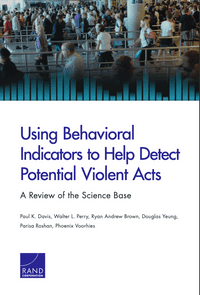Using Behavioral Indicators to Help Detect Potential Violent Acts: A Review of the Science Base
[Behavioral Indicators to Detect Potential Violent Acts]
This report, authored by RAND, focuses on behavioral sciences relevant to threat detection. The study reviewed literature to present methods that government organizations can use to set priorities to prevent and detect potential violent acts. The purpose of this document is to help officials prioritize attention and investment, particularly in sustained efforts to measure real-world effectiveness of practices.
SUMMARY
This report focuses on analyzing and presenting methods for how government organizations can set priorities to prevent and detect potential violent acts. The report comes from a review of literature focusing on behavioral sciences relevant to threat detection. It targets the science base for using new or nontraditional technologies and practices to observe behaviors and how the data gathered from doing so might help detect potential violent attacks. The purpose of this document is to help officials prioritize attention and investment, particularly in sustained efforts to measure real-world effectiveness of methods. It intends to interest researchers, analysts, and officials contemplating future investments amidst tightening budgets. The report is concerned with individual-level indicators and does not extend to detecting society-level phenomena, such as social movements or insurgent groups. One important conclusion the report draws is that success in detection will be determined by a blend of information across types of behaviors and times.
This document was authored by the RAND Corporation after they were asked to present a report relevant to threat detection. Specifically, the research was prepared for the United States Navy and conducted within the RAND National Defense Research Institute, a federally funded research and development center sponsored by the Office of the Secretary of Defense, the Joint Staff, the Unified Combatant Commands, the Navy, the Marine Corps, the defense agencies, and the defense Intelligence Community. This report is available for free online in English at www.rand.org as a public service of the RAND Corporation. A nonprofit institution, the RAND Corporation helps improve policy and decision making through research and analysis. This report was sponsored by Dr. Ivy Estabrooke, Thrust Manager for the Human, Social, Culture and Behavior Modeling program, and Mr. Lee Mastoianni, Thrust Manager for Force Protection, of the Office of Naval Research. The authors of this document are Paul K. Davis, Walter L. Perry, Ryan Andrew Brown, Douglas Yeung, Parisa Roshan, and Phoenix Voorhies.


..png)
